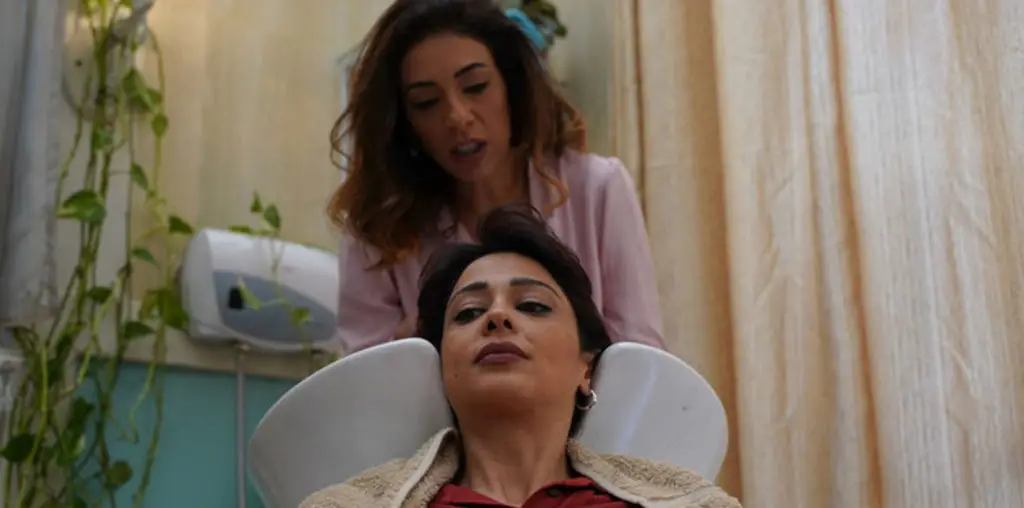
“My influences are pretty standard — ‘The Wizard of Oz,’ ‘Citizen Kane,’ ‘Greed,’ ‘Faster Pussycat! Kill! Kill!'”
The Russ Meyer influence on “Deathbed” shines beyond question during a series of flashbacks of hapless victims, run through by the artist. Barry taps into Meyer’s playful, ‘anything goes—especially without clothes’ attitude and the effectiveness of narrating a plot and character’s intentions within just a few seconds. The bed enjoys its most satisfying meal thanks to a Barnum inspired opportunist couple, proffering the bed as ‘sexual rejuvenator’ to musty old men. It’s a sleazy slaughter with style, a grotesque black humor, and a creepy cabaret piano accompaniment.
“Maybe it worked to its benefit that we were playing off these different things.”
Like a pendulum swinging back and forth through Barry’s influences, “Deathbed” swings you from sensuous poetic to monstrous mattresses to a cheesy renaissance erotica — mostly on account of the main set: a stone and brick room filled with a conspicuously enormous bed with a style from another time.
The Bed; a symbol for rest, intimacies, sickness, birth, death, passionate love, and horror. Barry had originally wanted to buy a bed, but couldn’t find anything he liked, so he and his crew made their own, modeled after The Great Bed of Ware; created sometime in the late 1500s (in the middle of the renaissance) and presently resting peacefully in the Victoria and Albert Museum in London. Barry’s bed was constructed out of plywood with much less ornamentation, but none-the-less imposing by its four-poster girth. Enclosed within deep burgundy curtains, the bed is like a room in itself, possessing that vintage-sexy, stylish Hammer Horror Film flavor. “Deathbed” was also impacted by the films of Marco Ferreri (like his cannibalistic treat “Le Grande Bouffe”), especially when it came to the editing process. Barry saw how Ferreri would take a serious subject and completely change its impact and tone by how he cut the film and compressed time.
“Deathbed”‘s initial conventional horror film impulse changed in the editing process (which transpired over several years as Barry scraped film-funds together). The more conventional — and less interesting — stuff ended up being cut out.
“Because we had to live with it for so long, more and more we did what we wanted to do.”
Curious artistic touches surface throughout “Deathbed,” like the sizzling hands scene with Sharon’s brother (played by William Russ, who went on to a successful television career including roles such as Roger Lococco on “Wiseguy,” and Corey’s dad Alan on “Boy Meets World”). After having all the meat digested off his hands by the bed, the brother sits against the wall staring at what’s left coming out of his sleeves. It’s as if you’re looking at a long lost Magritte painting, tragic and hilarious. And those are real human bones; Barry had acquired a set of hand bones through a Canadian company selling human skeletal parts.
“I don’t think it was legal. We probably ended up with body parts from some poor untouchable from India.”
Suzan’s dream sequence will also disquiet your mind, and your stomach. The scene originally called for a cockroach.
“But where’s a cockroach when you need one?”
Having a hard time finding his bug of choice in the wild, Barry turned to the research laboratories of Wayne State University in Detroit. What he ended up with was one of the insects a lab was using for experimentation, a tropical winged cockroach, “…the size of a small dachshund.”
“Julie, poor Julie…”
As Suzan, Julie Ritter sits behind the huge winged cockroach crawling on a plate of guacamole, with a voice telling her she must eat. And this green-gooey nightmare ends with a crunch.
It’s a shame Barry, now 54, hasn’t made a film since “Deathbed,” which he finally finished in 1977. Since then, he’s switched his sights to the economically viable art of bookselling. However, his 18-year-old daughter Darcy (she and brother Sean videoed dad’s DVD introduction) may be able to re-ignite Barry’s bewitching, and quite strange, infatuation with celluloid.
“If I had seen in a crystal ball that the film would never be released for over 25 years, I would have done straight horror.”
Lucky for us he didn’t. Instead, we have a marvelous oddity the equivalent of a child’s fanciful, monsters-in-the-closet imagination running wild and naked through Barry’s uncensored libido, found after being lost for years in a ‘we can’t sell this’ black hole.
“I was always glad I made the film. I was always glad I finished it…It’s like a ghost that’s kind of popped up.”
Yesterday’s disinterest in carnal and carnivorous pillow talk is today’s Epic treasure. This bedtime story’s time has finally come.
